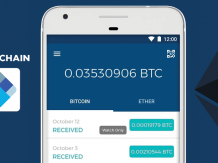Indias new net neutrality regime puts the US to shame
Log infor two more free articles, orsubscribe now
Visitors are allowed 3 free articles per month (without a subscription), and private browsing prevents us from counting how many stories youve read. We hope you understand, and considersubscribingfor unlimited online access.
Subscribe nowfor unlimited online access.
A new analysis shows how the cost of securing Bitcoin will constrain its growth.
Human labor is propping up some companies fake AI software
The Downloadnewsletter with top tech stories delivered daily to your inbox
Subscribe nowfor unlimited online access.
MIT Technology Review © 2018v.ei
Keep up with the latest in blockchain at EmTech MIT.
The tech behind the Thailand cave rescue
The emergence of governments and banks provided organized, central authorities to which we could outsource trustas long as we trusted them.
Soon, technologists realized that blockchains could be used to track other things besides money. In 2013, 19-year-old Vitalik Buterin proposed Ethereum, which would record not only currency transactions but also the status of computer programs called smart contracts. Launched in 2015, Ethereumand now a host of competitors and imitatorspromises to make possible a new generation of applications that look and feel like todays web apps but are powered by decentralized cryptocurrency networks instead of a companys servers.
Human labor is propping up some companies fake AI software
The mission of MIT Technology Review is to bring about better-informed and more conscious decisions about technology through authoritative, influential, and trustworthy journalism.
These anti-aging pills seem to be actually working
We noticed youre browsing in private or incognito mode.
Unlimited online access including all articles, multimedia, and more
Apublic1,permanent2,append-only3distributed4ledger5.
This is your last free article this month.
In Bitcoin, a transaction is the transfer of cryptocurrency from one person (Alice) to another (Bob). In Ethereum, which includes a built-in programming language that can be used to automate transactions, there are multiple kinds. Alice can send cryptocurrency to Bob. Or someone can create a transaction that places a line of code, called a smart contract, on the blockchain. Alice and Bob can then send money to an account this program controls, to trigger it to run if certain conditions encoded in the contract are met. A smart contract can also send transactions to the blockchain in which it is embedded.
The hash must meet certain conditions; if it doesnt, the miner tries another random nonce and calculates the hash again. It takes an enormous number of tries to find a valid hash. This process deters hackers by making it hard to modify the ledger. While some blockchain entities use other systems to secure their chains, this approach, called proof of work, is the most thoroughly battle-tested.
of three free articles this month.Subscribe nowfor unlimited online access.
Blockchains distributed across thousands of computers can mechanize trust, opening the door to new ways of organizing decentralized enterprises and institutions.
A subset of nodes, called miners, organize valid transactions into lists called blocks. A block in progress contains a list of recent valid transactions and a cryptographic reference to the previous block. In blockchain systems like Bitcoin and Ethereum, miners race to complete new blocks, a process that requires solving a labor-intensive mathematical puzzle, which is unique to each new block. The first miner to solve the puzzle will earn some cryptocurrency as a reward. The math puzzle involves randomly guessing at a number called a nonce. The nonce is combined with the other data in the block to create an encrypted digital fingerprint, called a hash.
Discover where tech, business, and culture converge.
Indias new net neutrality regime puts the US to shame
Youve read all your free articles this month.
BitcoinBusiness of Blockchain 2018MIT Technology Review EventsblockchaincryptocurrencyICOInitial coin offerings
Subscribe nowfor unlimited online access.
Log infor more, orsubscribe nowfor unlimited online access.
Unlimited online access including articles and video, plus The Download with the top tech stories delivered daily to your inbox.
A mathematical structure for storing data in a way that is nearly impossible to fake. It can be used for all kinds of valuable data.
Ping An Technology is investing in AI tools that will transform and democratize personal finance, healthcare and education.
Ive been working on a new electronic cash system thats fully peer-to-peer, with no trusted third party. These are the words of Satoshi Nakamoto, the mysterious creator of Bitcoin, in a message sent to a cryptography-focused mailing list in October 2008. Included was a link to a nine-page white paper describing a technology that some are now convinced will disrupt the financial system.
Meet Oasis Labs, the blockchain startup Silicon Valley is buzzing about
Revert to MIT Enterprise Forum pricing
Not an Insider? Subscribe now for unlimited access to online articles.
What it means to be constantly connected with each other and vast sources of information.
By signing up you agree to receive email newsletters and notifications from MIT Technology Review. You can unsubscribe at any time. View ourPrivacy Policyfor more details.
Bitcoins popularity began to grow quickly in 2011, after a Gawker article exposed Silk Road, a Bitcoin-powered online drug marketplace. Imitators called altcoins began to emerge, often using Bitcoins open-source code. Within two years, the total value of bitcoins in circulation had passed $1 billion.
Meet Oasis Labs, the blockchain startup Silicon Valley is buzzing about
Lets say Alice wants to send some money to Bob. To do so, Alice creates a transaction on her computer that must reference a past transaction on the blockchain in which she received sufficient funds, as well as her private key to the funds and Bobs address. That transaction is then sent out to other computers, or nodes, in the network. The nodes will validate the transaction as long as it has followed the appropriate rules. Then mining nodes (more on those in step 3) will accept it, and it will become part of a new block.
To continue reading this article, please exit incognito mode orlog in.
Combining software with something the company calls trusted hardware will vastly expand what smart contracts can do.
These anti-aging pills seem to be actually working
Early civilizations used threat of force as retribution for dealing in bad faith when engaging in trade.
The tech behind the Thailand cave rescue
Nakamoto mined the first bitcoins in January 2009, and with that, the cryptocurrency era was born. But while its origin is shadowy, the technology that made it possible, which we now call blockchain, did not arise out the blue. Nakamoto combined established cryptography tools with methods derived from decades of computer science research to enable a public network of participants who dont necessarily trust each other to agree, over and over, that a shared accounting ledger reflects the truth. This makes it virtually impossible for someone to spend the same bitcoin twice, solving a problem that had hindered previous attempts to create digital cash. And, crucially, it eliminates the need for a central authority to mediate electronic exchange of the currency.
Its a new way of answering an old question: how can we create enough trust between one another to peacefully exchange something of value?
Meet Oasis Labs, the blockchain startup Silicon Valley is buzzing about
This is the final step in securing the ledger. When a mining node becomes the first to solve a new blocks crypto-puzzle, it sends the block to the rest of the network for approval, earning digital tokens in reward. Mining difficulty is encoded in the blockchains protocol; Bitcoin and Ethereum are designed to make it increasingly hard to solve a block over time. Since each block also contains a reference to the previous one, the blocks are mathematically chained together. Tampering with an earlier block would require repeating the proof of work for all the subsequent blocks in the chain.



